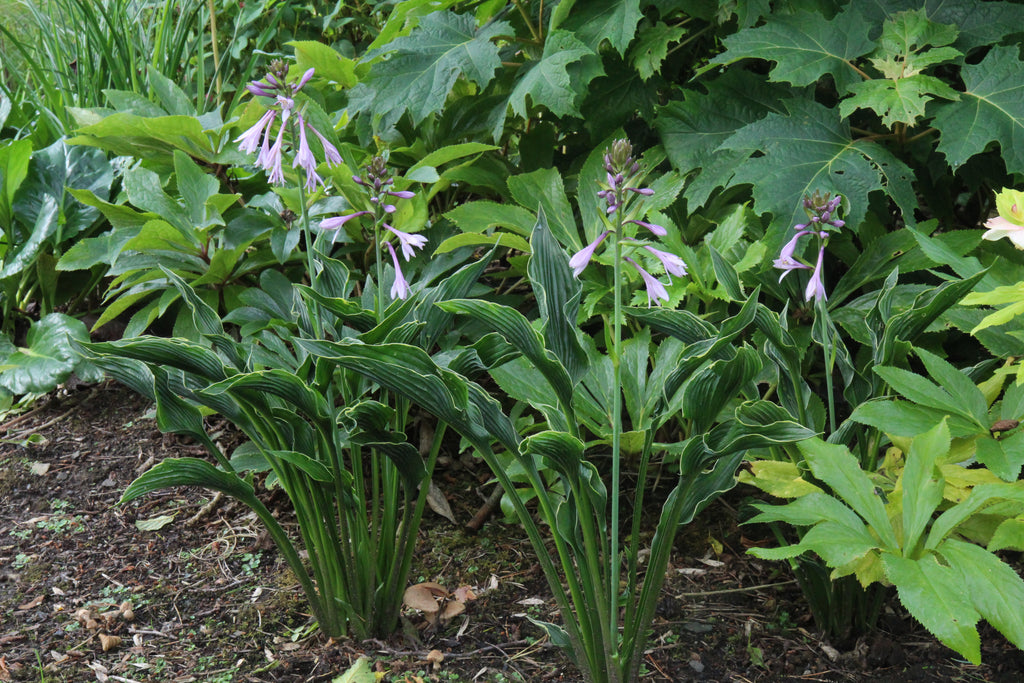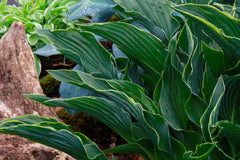



About this cultivar:
Hosta 'Praying Hands' (v) is a plant of unidentified parentage and was registered by Gerald Williams of Minnesota in 1996. An unusual plant resembling ...praying hands.....
It produces a medium size, semi-upright mound of foliage with a thin white marginal variegation and lavender flowers on reddish stems. The very narrow leaves are very wavy and fold upwards.
According to The Hosta Handbook by Mark Zilis (2000),"...one of the weirdest cultivar introductions in many years; exact origin unknown, but most likely a sport of some Fortunei'..."
The New Encyclopedia of Hostas by Diana Grenfell (2009) states: "Grow at eye level to get the best effect from the unusual leaf habit. Plant with a collection of ferns or small hostas with contrasting, hear-shaped leaves. Not just an interesting hosta but an unusual and interesting foliage plant."
It was the 2011 "Hosta of the Year" by the American Hosta Growers Association and was awarded the Royal Horticultural Society's Award of Garden Merit in 2012.
- Position: Full sun, partial shade, full shade
- Soil: Almost any soil, grows well in Ballyrobert
- Flowers: June, July
- Other features: Grows well in Ballyrobert, Interesting Foliage or Fruit, Suitable for Container, Dappled Shade or Full Shade Loving, Royal Horticultural Society Award of Garden Merit (RHS AGM)
- Hardiness: H7 - Hardy in the severest European continental climates (< -20°C), Fully hardy - grows well in Ballyrobert!
- Habit: Clump forming
- Foliage: Deciduous
- Height: 30 - 45 cm (1 - 1.5 ft)
- Spread: 30 - 60 cm (1 - 2 ft)
- Time to full growth: 2 to 5 years
- Plant type: Herbaceous Perennial
- Colour: Green, yellow
- Goes well with: Cornus, ferns, allium
About this genus:
Hosta (hos-ta) is a genus of plants commonly known as plantain lilies, giboshi, or the old botanical name Funkia. The name Hosta is in honor of the Austrian botanist Nicholas Thomas Host. However most modern plants were introduced from Japan to Europe by Philipp Franz von Siebold in the mid-19th century. Don't worry about Philipp's legacy being forgotten though; he has a species named after him! (Hosta sieboldiana).
Hosta are often touted as the best shade-loving plants for the perennial garden, which is hard to dispute. In cultivation, Hosta readily mutate and have produced thousands of novel colours and leaf forms (blue, gold, and variegated are the most popular). Because of their great foliage Hosta are often thought of as foliage-only plants, but it is worth noting that many cultivars have fantastic flowers - see "Sum and Substance" and "Stained Glass" for example.
You will read that for best performance, Hosta prefer to be out of full-sun. However if you live on these islands it is doubtful you will ever get any full-sun; so you may try them in your brightest spot as long as they have some moisture. You may have had some experience with slugs and Hosta. So have we. We have found that cultivars matter (some are tastier to slugs than others) so we try to grow only slug resistant cultivars or ones that grow so many new leaves the slugs can't keep up. We've also found that, by not using chemicals, little mites that eat slugs eggs multiply and keep the population down - let nature run its course! Some slug-loving-predator should turn up eventually!
How to use Hosta? Well, if you are paranoid about slugs, place the plant in the middle or back of the border where you can only see the upper part of the plant. Slugs don't climb so high so the lower leaves that get slug damaged won't be seen! As for plant partners we put some red stemmed dog-woods near or through them (Cornus), or large leaf-ferns. It is common to put bulbs in and around Hostas; we do it with Allium. But we don't do it with Narcissi or Tulipa; they don't like the competition.

